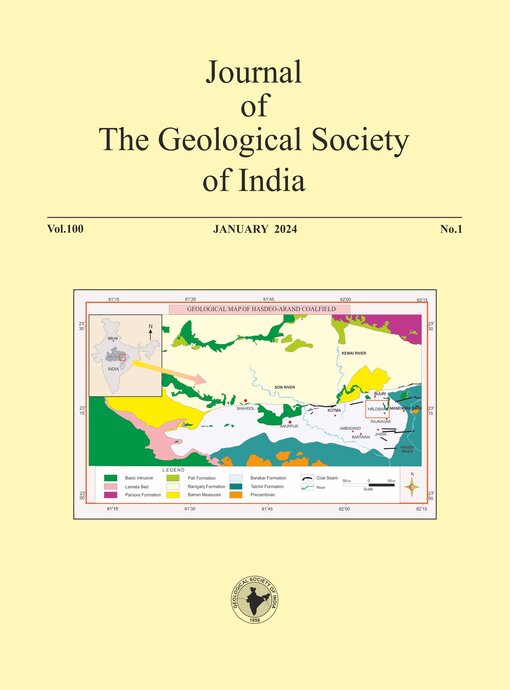Structural and Stratigraphic Study of Hazara-Kashmir Syntaxis with the Aid of Geographic Information System and Field Data Approach
Keywords:
No KeywordsAbstract
This research area is located along the Hazara-Kashmir Syntaxis in the sub-Himalaya. The Hazara-Kashmir Syntaxis runs through numerous areas within Mirpur district. One of the key characteristics of the Hazara-Kashmir Syntaxis is its antiformality. The project area is bounded to the east by the Riasi fault and to the west by the Jhelum fault, while to the south it is bounded by Salt Range Thrust. Research is being conducted in the areas of Narmah, Sahan, Pirgali, Kas Guma, Mohra Jangu, and Kalri. Fold-and-thrust belts are present in the sub-Himalayan region. Essentially, there are two major folds: the Sahan syncline and the Gaiyan anticline. The Sahan syncline is characterized by an open fold and a southwest orientation. In contrast, open-toclose folds in Gaiyan anticlines are oriented to the southwest. The area is characterized by five major faults: the Narmah fault, the Dhok Poran fault, the Dubal fault, the Pirgali fault, and the Jabi fault. Folds and faults in the project area are the product of NESW or NW-SE compaction of the Himalaya. In the research project area sedimentary rocks of Early Miocene-Recent age are located. The rocks which are exposed in the study area includes: the Early- Middle Miocene Kamlial Formation, Middle-Late Miocene Chinji Formation, Late-Miocene Nagri Formation, Late-Miocene Dhok Pathan Formation, Pliocene Soan Formation, and Quaternary Alluvium deposits. Sedimentary structures in the area consist primarily of crossed bedding and rip-ups. These structures define the facing of stratigraphic units.
Downloads
Metrics
Issue
Section
Downloads
Published
How to Cite
References
Ahmad, M., Iqbal, O. and Abd Kadir, A. (2017) Quantification of organic richness through wireline logs: a case study of Roseneath shale formation, Cooper basin, Australia. IOP Conference Series: Earth and Environmental Science.
Akhtar, S.S., Ahmad, M., and Hussain, A. (2004) Geological mapping of the Dadyal area, Mirpur district AJK and part of the Rawalpindi District, Punjab, Pakistan: Pak. Geol. Surv., Geol. map series, v.6, no.25.
Ashraf, M. and Chaudhary, M.N. (1984) Petrology of lower Siwalik rocks of Poonch area. Kashmir Jour. Geol., v.2, pp.1-10.
Baig, M.S. and Lawrence, R.D. (1987) Precambrian to early Paleozoic orogenesis in the Himalaya: Kashmir Jour. Geol., v.5, pp.1-22.
Baig, M.S., Yeats, R.S., Pervez, S., Jadoon, I.A.K., Khan, M.R., Siddiqui, I., Monalisa, Saleem, M., Masood, B., Sohail, A., Mughal, M.S., Ahmed, M.J., Butt, W.A., Rehman, H., Abbasi, H.R., Abbasi, N., Nadeem, M. (2010) Active tectonics, October 8, 2005 earthquake deformation, active uplift, scarp morphology and seismic geohazards microzonation, Hazara Kashmir Syntaxis. NW Himalayas, Pak. Jour. Him. Earth Sci., v.43, pp.17- 21.
Bossart, P., Dietrich, D., Greco, A., Ottiger, R. anf Ramsay, J.G. (1988) The tectonic structure of the Hazara Kashmir syntaxis, southern Himalayas, Pakistan. Tectonics, v.7(2), pp.273-297.
Davies, L.M. and Pinfold, E.S. (1937) The Eocene beds of the Punjab Salt Range, India. Geol. Surv. India Mem., Palaeont. Indica Series, v.4(1), 79p.
Fatmi, A.N. (1973) Lithostratigraphic units of the Kohat-Potwar Province, Indus basin, Pakistan. Geol. Surv. Pakistan Mem., no.10, 80p.
Iqbal, O., Ahmad, M. and Abd Kadir, A.A. (2017) Geomechanical characterization of potential Roseneath shale gas, Cooper basin, Australia. Jour. Engg. Appl. Sci., v.12(17), pp.5221-5231.
Islam, M. (2006) Structure, stratigraphy, petroleum geology and tectonics of Mirpur, Khuiratta and Puti Gali areas of district Mirpur and Kotli, Jammu and Kashmir, Pakistan; Unpubld. M.S. thesis, Institute of Geology, Univ. of Jammu and Kashmir, Muzafarabad, Pakistan, 170p.
Khan, M., Li, H., Khan, A., Hussain, W., Khan, R. and Ali, R. (2023) Mechanical properties of selected granitoids along the Karora hydropower project, Besham, Northern Pakistan: Insights from petrography and joint analysis. Frontiers in Earth Science, v.10, 1096850.
Khawaja, A.A. (2004) Structural trends and focal mechanism studies in the Potwar area with special emphasis on hydrocarbon exploration: Pak. Jour. Hydroc. Rec., v.14, pp.49-59.
Kravtchenko, K.N. (1964) Soan Formation upper units of Siwalik Group in Potwar. Science and Industry, v.2(3), pp.230-233.
Lewis, G.E. (1937) A new Siwaliks correlation (India). Amer. Jour., Sci., Series 5, No.195, v.33, pp.191-204.
Lydekker, R. (1883) The geology of Kashmir and Chamba territories and the British district of Kaghan: Geol. Surv. India Mem, v.22, 344p.
Meddlicott, H.B. (1876) Notes upon the sub-Himalayan series in the Jammu Hills. Geol. Surv. India, Rec., v9, pp.49-57.
Munir, M.H., and Baig, M.S. (2006) Paleogene biostratigraphy of Tattapani, Kotli Kashmir, northwest sub-Himalayas, Pakistan. Jour. Him. Earth Sci., v.39, pp.39-48.
Pilgrim, G. E. (1913) Preliminary notes on a revised classification of the Tertiary freshwater deposits of India. Geol. Surv. India Rec., v.40(3), pp.185-205.
Pinfold, E.S. (1918) Notes on structure and stratigraphy in the north-west Punjab. Geol. Surv. India Rec., v.49, pt.3, p.137-160.
Shah, S.M.I. (1977) Stratigraphy of Pakistan. Geol. Surv. Pak. Mem., v.12, 138p.
Wadia, D.N. (1928) The geology of the Poonch State (Kashmir) and adjacent portion of the Punjab. Geol. Surv. India Mem., v.51, pt. 2, pp.185-370.
Wynne, A. (1874) Observations on some features in the physical geology of the Outer Himalayan Region of the Upper Punjâb, India. Quart. Jour. Geol. Soc., v.30(1-4), pp. 61-80.

 Musa Khan
Musa Khan


